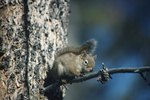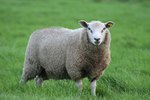
Deer are herd animals who combine physical characteristics with natural instincts in order to survive in the wild and communicate with other members of the herd. If you are unfamiliar with deer, you may not be able to pinpoint basic parts of deer anatomy or understand the purpose of all those body parts.
Scent Glands
Deer communicate with one another using scent, sound and body language. Without these methods of communication, deer would have difficulty marking their territory and finding acceptable mates. The bags on the inside of a deer's rear legs are actually scent glands that deer use to spread their odor and communicate reproductive information to other animals in the area.
Tarsal Glands
The tarsal glands are located on the inside of a deer's legs. The tarsal gland area of the leg consists of an area of long hairs covering enlarged, fatty sebaceous glands that secrete a musky odor. Both does and bucks have tarsal glands. The odor that is created by these glands is enhanced when the deer urinates on the glands and rubs the glands together. Deer rub their tarsal glands together more often during the breeding season. The scent of the tarsal gland is used by deer to help them identify other herd members and determine whether or not they are suitable marriage material.
Metatarsal Glands and Interdigital Gands
In addition to the tarsal glands, the metatarsal glands and interdigital glands are also located on a deer's leg. Very little is known about the purpose of either of these glands. The metatarsal glands are located on the outer part of the deer's hind legs, halfway up the heel. The interdigital glands are located on all four of the deer's feet in the area between the hooves.
Bacteria in the Tarsal Gland
The tarsal gland contains bacteria, partially due to the rub-urination process. It's best to avoid touching the tarsal glands of a deer, whether the deer is alive or dead. If you are going to touch a deer, you should wear gloves or make sure to wash your hands thoroughly afterwards.
References
Photo Credits
-
Tom Brakefield/Stockbyte/Getty Images
Writer Bio
Jen Davis has been writing since 2004. She has served as a newspaper reporter and her freelance articles have appeared in magazines such as "Horses Incorporated," "The Paisley Pony" and "Alabama Living." Davis earned her Bachelor of Arts in communication with a concentration in journalism from Berry College in Rome, Ga.




